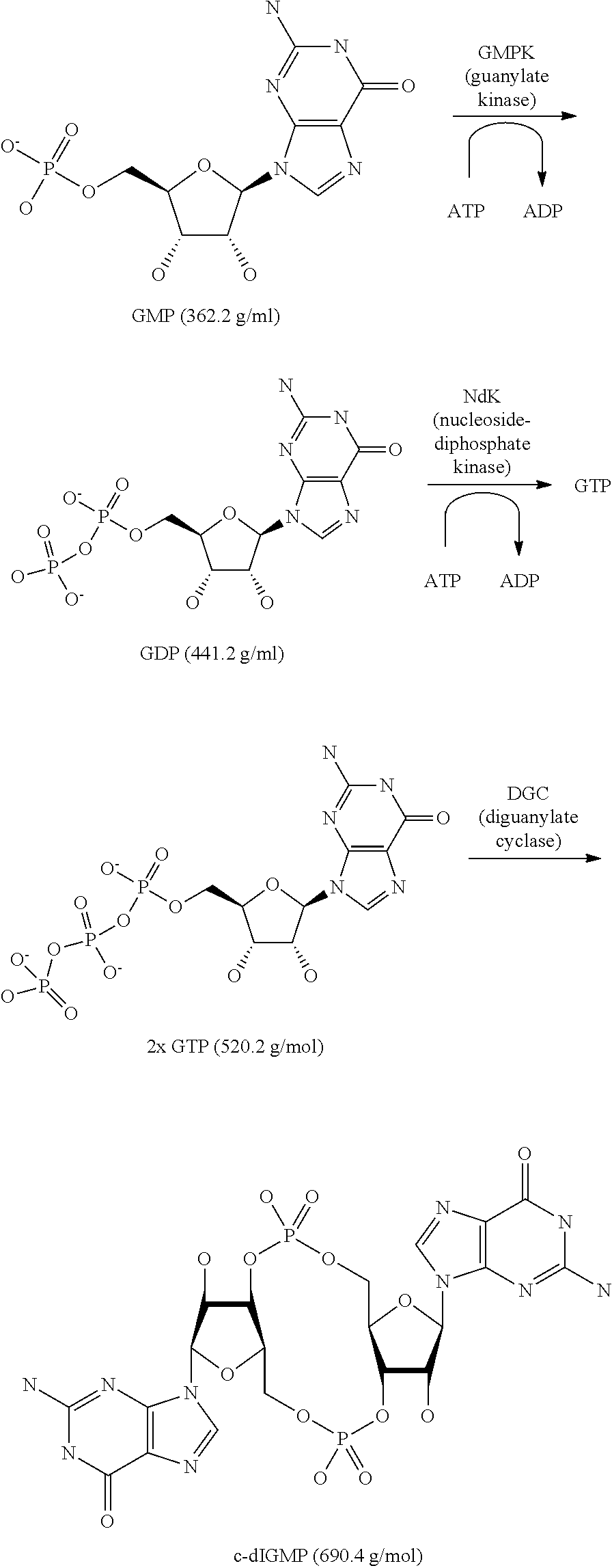Process for the enzymatic production of cyclic diguanosine monophosphate employing a diguanylate cyclase comprising a mutated rxxd motif
a diguanylate cyclase and cyclic diguanosine monophosphate technology, applied in biochemistry apparatus and processes, enzymes, sugar derivatives, etc., can solve the problems of less than 25%, low overall yield, and large loss of produ
- Summary
- Abstract
- Description
- Claims
- Application Information
AI Technical Summary
Benefits of technology
Problems solved by technology
Method used
Image
Examples
example 1
[0045]This Example describes the gene cloning, overexpression, purification and characterization of guanylate kinase and nucleoside diphosphate kinase from Escherichia coli
a) Gene Cloning of E. coli gmpk and E. coli ndk
Based on the Genbank database DNA sequences of E. coli GmpK (M84400) and E. coli NdK (X57555), primer were designed for PCR amplification of the respective genes:
Ec-gmpK-forGGGATCCATGGCTCAAGGCACGCTTTATATTGTTTCTGEc-gmpK-revGAAGCTTCAGTCTGCCAACAATTTGCTGEc-ndk-forGGGATCCATGGCTATTGAACGTACTTTTTCCATCEc-ndk-revGAAGCTTAACGGGTGCGCGGGCACACTTC
Introduced cloning sites are underlined. Start and stop codons of the genes are in bold.
Genomic DNA was isolated from E. coli JM109 by standard methods (Joseph Sambrook and David W. Russell. Molecular Cloning: A Laboratory Manual. Cold Spring Harbor Laboratory Press, Cold Spring Harbor, N.Y.). PCR was performed using 4 ng / ml genomic DNA template and 0.5 M of each primer in standard PCRs (30 cycles, 30 sec extension time, 57° C. and 62° C., ...
example 2
a) Gene Cloning of C. Crescentus dgcA
[0047]Based on the Genbank database DNA sequences of C. crescentus dgcA (cc—3285; ACCESSION AE005673) primer were designed for PCR amplification of the respective genes:
Cacr-002CAGAAGCGTTGTCGTGCCCATGGTTGCacr-004TTGCAGGCCAATGTGGTCATGGGCGGCATCGTCGGCCGCATGGGCacr-010GGTCTAGAATGAAAATCTCAGGCGCCCGGACCCacr-011CAGGATCCCGATCAAGCGCTCCTGCacr-014GGTCTAGACATATGAAAATCTCAGGCGCCCGGA
Introduced cloning sites are underlined. Start codon of dgcA is in bold.
PCR was performed using 4 ng / ml genomic DNA of C. crescentus CB15 template and 1.0 μM of primer Cacr-002 / Cacr-004 in a standard PCR (35 cycles, 30 sec extension time, 55° C., annealing temperature). The expected DNA bands representing the 3′-end of the dgcA gene including the R153V-E154M-S155G-D155G mutation was observed after 1% TBE agarose gel electrophoresis. The respective PCR band was excised, the DNA fragment purified by QIAquick PCR Purification Kit (Qiagen) and used as a megaprimer in the next PCR reaction ...
example 3
[0049]This Examples illustrates the production of c-di-GMP from GMP 1250 ml freshly refolded DgcA, 5000 U NdK (2.8 U / μl in 50% Glycerol), 5000 U GmpK (3.6 U / μl in 50% Glycerol), Guanosine 5′-monophosphoric acid (GMP, 4 g, 11 mmol), 13.75 g Adenosine 5′-triphosphoric acid disodium salt (ATP), and 3750 ml reaction buffer containing 50 mM Tris-HCl, pH 7.5, 10 mM MgCl2, 0.5 mM EDTA and 50 mM NaCl were mixed and incubated, slightly shaking with 80 rpm, at 30° C. for 16 h.
Purification
[0050]The crude reaction mixture (4800 ml) was filtered through cellulose and added to an anion exchange column (Dowex 1×2, 400 ml Pharmacia XK26, 2.5 cm inner diameter, approx. 70 cm length; Cl-form, extensively washed with 0.5% acetic acid, equilibrated with water (2000 ml); flow rate 10 ml / min).
[0051]The column was washed with water (2000 ml, 10 ml / min), 2M NH4OAc (2000 ml, 10 ml / min), water (1500 ml, 10 ml / min), 10 mM HCl / 50 mM LiCl (1000 ml, 10 ml / min).
[0052]Product was eluted from the ion exchange colum...
PUM
| Property | Measurement | Unit |
|---|---|---|
| diameter | aaaaa | aaaaa |
| temperature | aaaaa | aaaaa |
| temperature | aaaaa | aaaaa |
Abstract
Description
Claims
Application Information
 Login to View More
Login to View More - R&D
- Intellectual Property
- Life Sciences
- Materials
- Tech Scout
- Unparalleled Data Quality
- Higher Quality Content
- 60% Fewer Hallucinations
Browse by: Latest US Patents, China's latest patents, Technical Efficacy Thesaurus, Application Domain, Technology Topic, Popular Technical Reports.
© 2025 PatSnap. All rights reserved.Legal|Privacy policy|Modern Slavery Act Transparency Statement|Sitemap|About US| Contact US: help@patsnap.com


